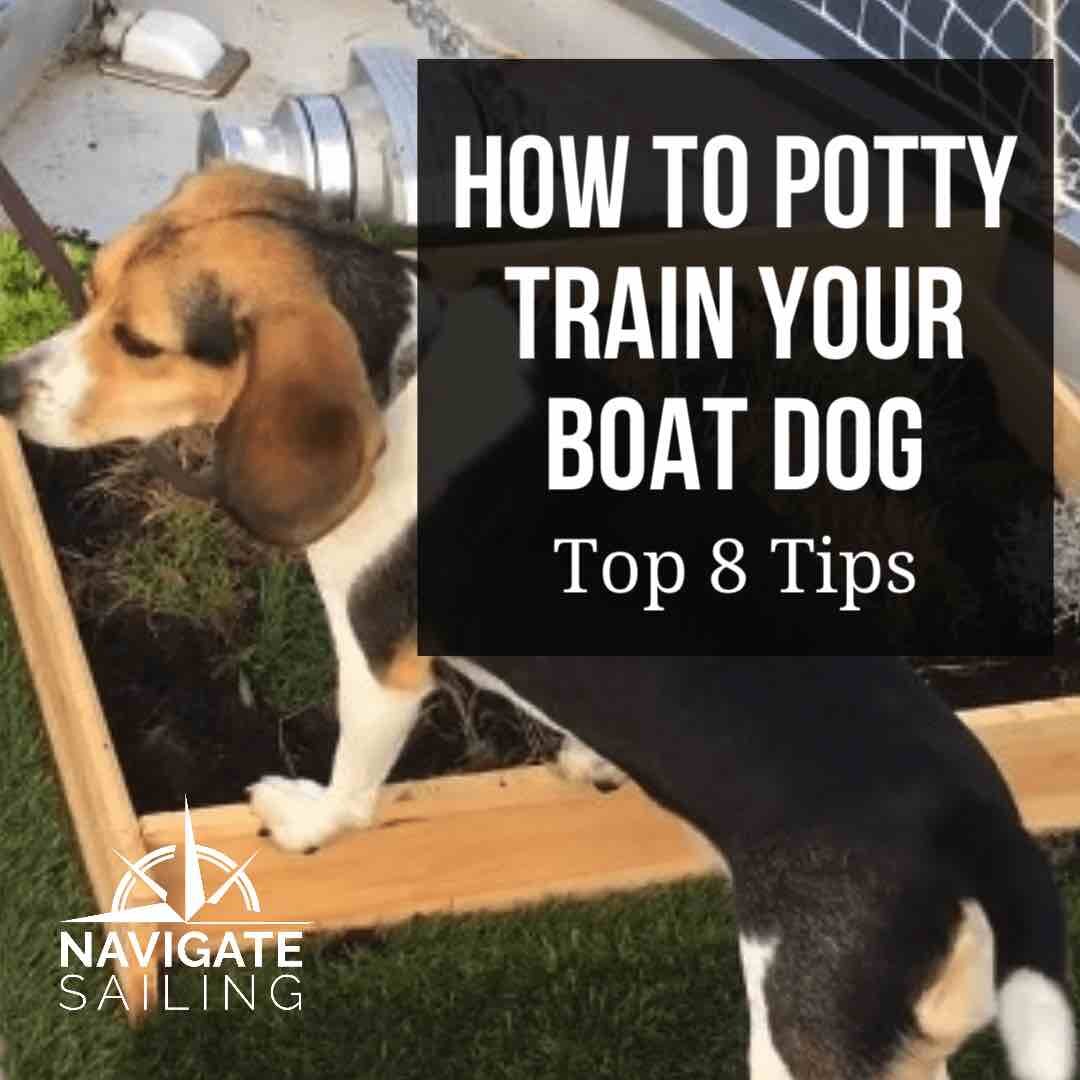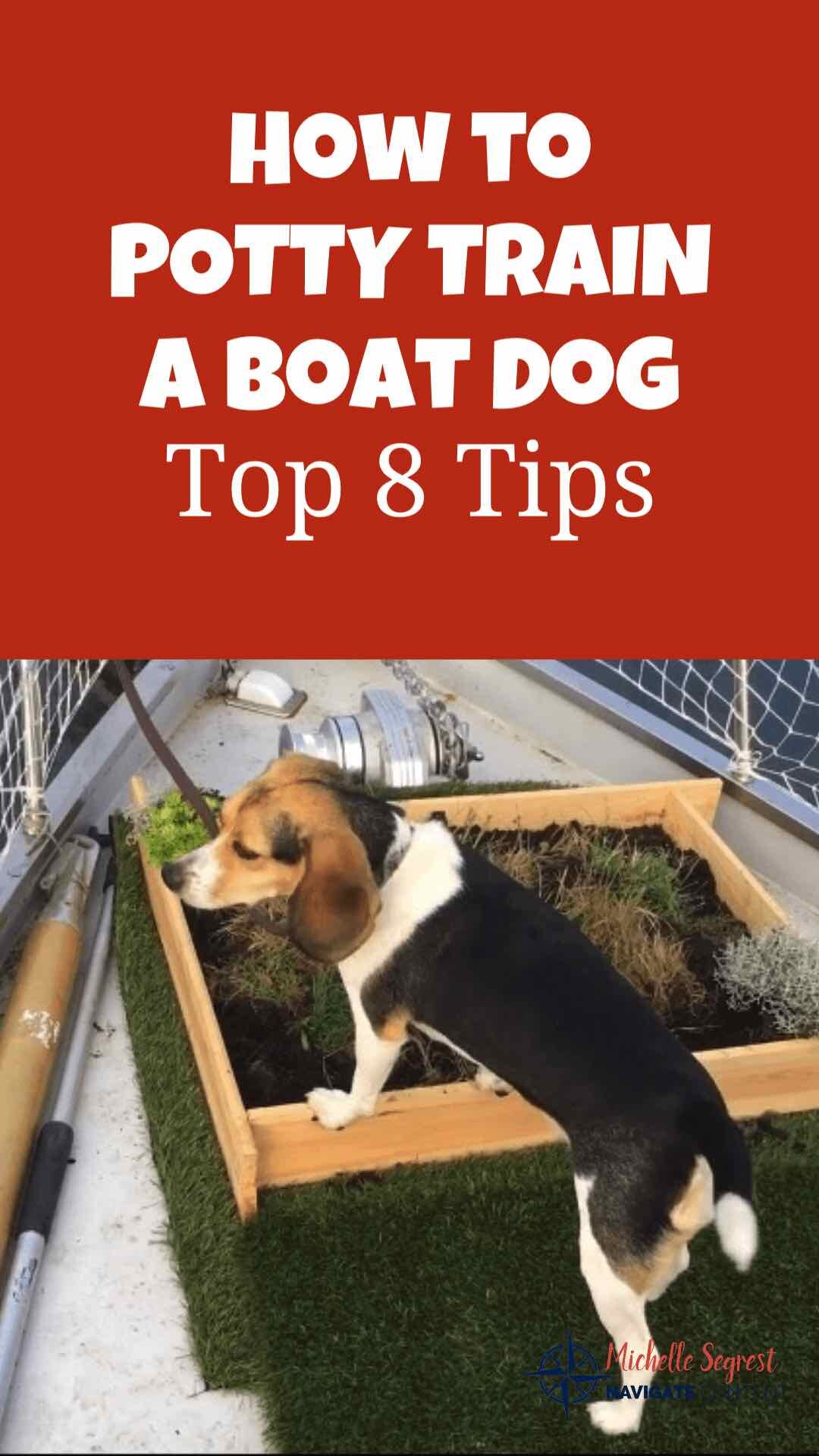How to Potty Train a Boat Dog – Top 8 Expert Tips
/Potty training a boat dog requires patience, persistence, consistency, and a little advice from some the experts who have successfully done it!
By Michelle Segrest – How to Get Your Sea Legs
While sailing the world with dogs for a year, without a doubt, the question that I am asked the most often is, “Where do the dogs do their business on board?”
It’s a great question. And now after a lot of experience and practice, I can answer it easily. We successfully used a fake-grass mat on the bow of our ship and established it as Cap’n Jack and Scout’s “place to go.” When we are at sea and conditions are not safe for the beagles to go to the bow to potty, we have a spare fake-grass mat that we put in the cockpit. In those circumstances, we just deal with the smell and clean it later when conditions allow.
Simple, right? Well, I must admit that it took some effort to accomplish this task. Just like when potty training a dog in your house, potty training on board requires consistency, a reward system, and routine. It’s most definitely doable, but it also requires patience. We trained our dogs to potty on a sailboat, but these tips should help you no matter what kind of boat you decide to use to enjoy the water with your furry family members.
Top 8 Tips for Potty Training a Boat Dog
1. Establish a safe place on board that will be your pet’s “place to go.”
For us, we established the bow of the boat. Some sailor friends who have a catamaran used the trampoline as the dog’s potty place. It doesn’t matter where you designate the spot as long as it always stays the same.
2. Purchase a fake grass mat, or build a dog yard with real grass, and leave it in the designated spot.
We found a fake grass mat that looks and feels (sort of) like real grass. At first, the dogs took naps on the mat, and we wondered if this was counterproductive, but eventually they realized this was their place to go. Our skipper decided to build a real grass area by constructing a dog yard and trying to grow grass in it. This didn’t work for us, but it may have been a good idea if we were mostly sitting at anchorage and not sailing in heavy offshore conditions.
3. If needed, place a pee or poo sample on the mat so they will recognize the scent.
We tried this and it worked. On a walk, I collected a poo sample in a doggie bag and transported it to the fake grass mat. Cap’n Jack was the first to catch on and once he deposited some fresh samples, then Scout joined the fun.
4. Put your dogs on a leash and “walk” them to their place as if you were taking them on a walk.
While in port, we realized that the dogs knew a walk was in their future so they chose to hold it. They knew there were options. I would leash them and walk them to fake grass mat and not let them have their real walk until after they did their business. This required a lot of patience on the part of the humans, but it was an effective method.
5. To potty train a boat dog, use treats, praise, and rewards, and do this consistently.
Whenever Cap’n Jack or Scout used the fake grass mat, we threw a party! We would give them treats and lots of petting and love and enthusiasm. They definitely began to understand that this was a very good thing and understand the reward for repeating the behavior.
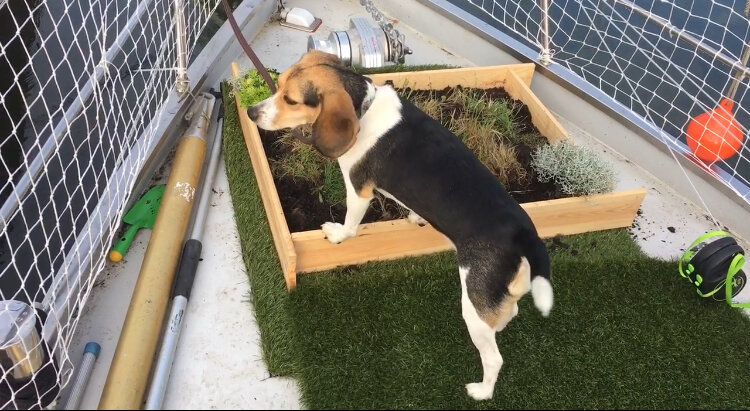
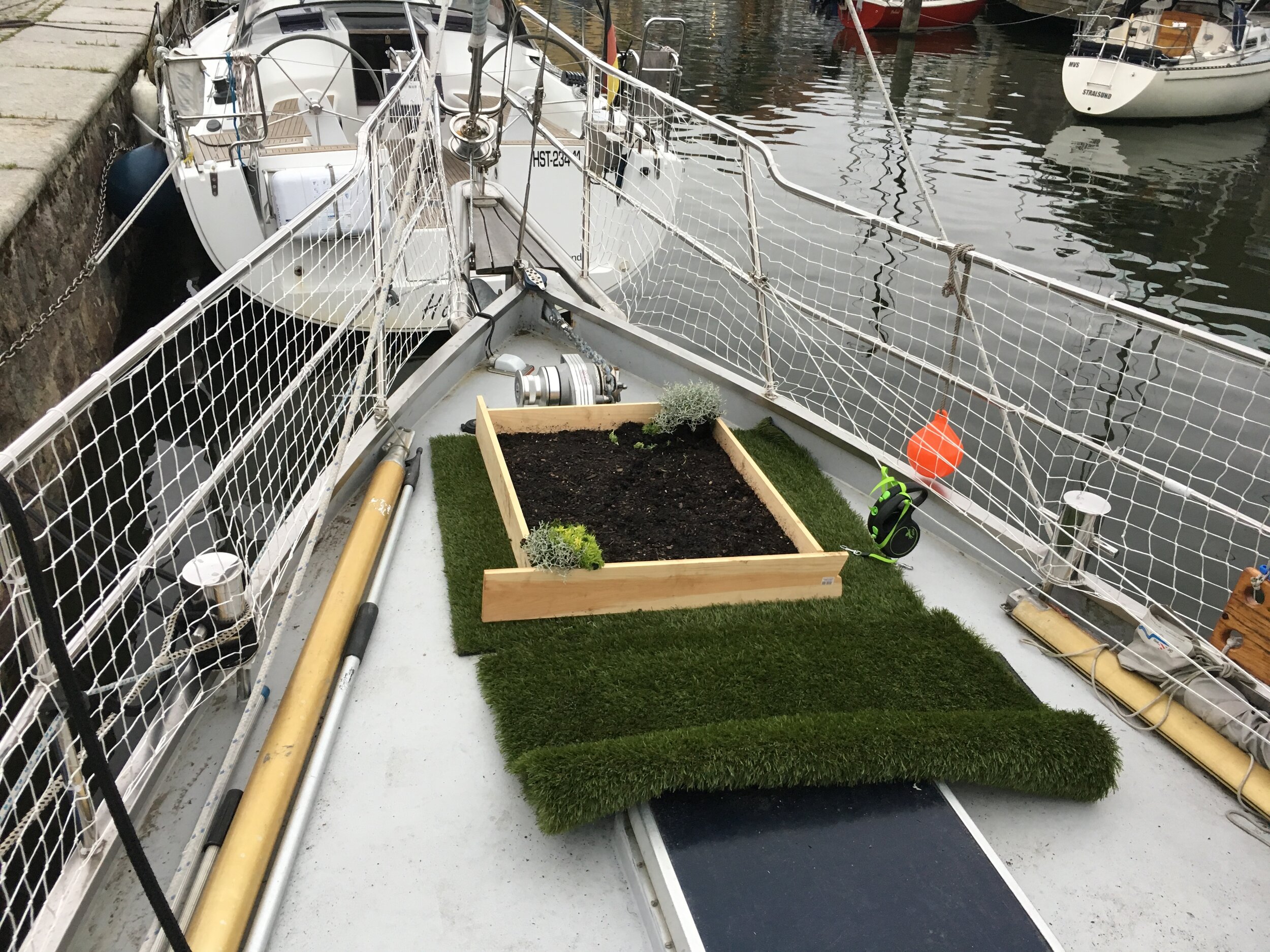
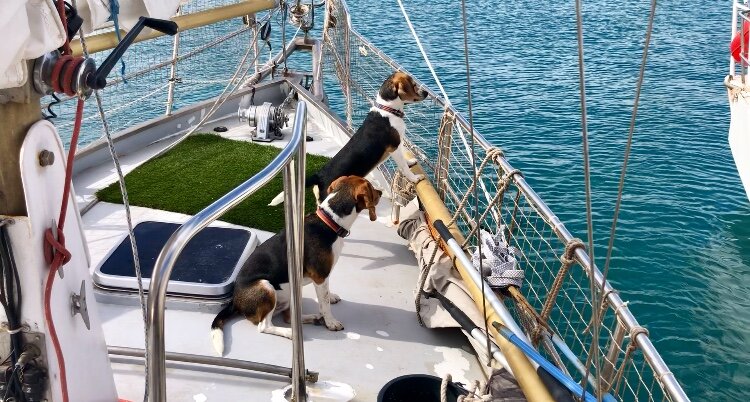
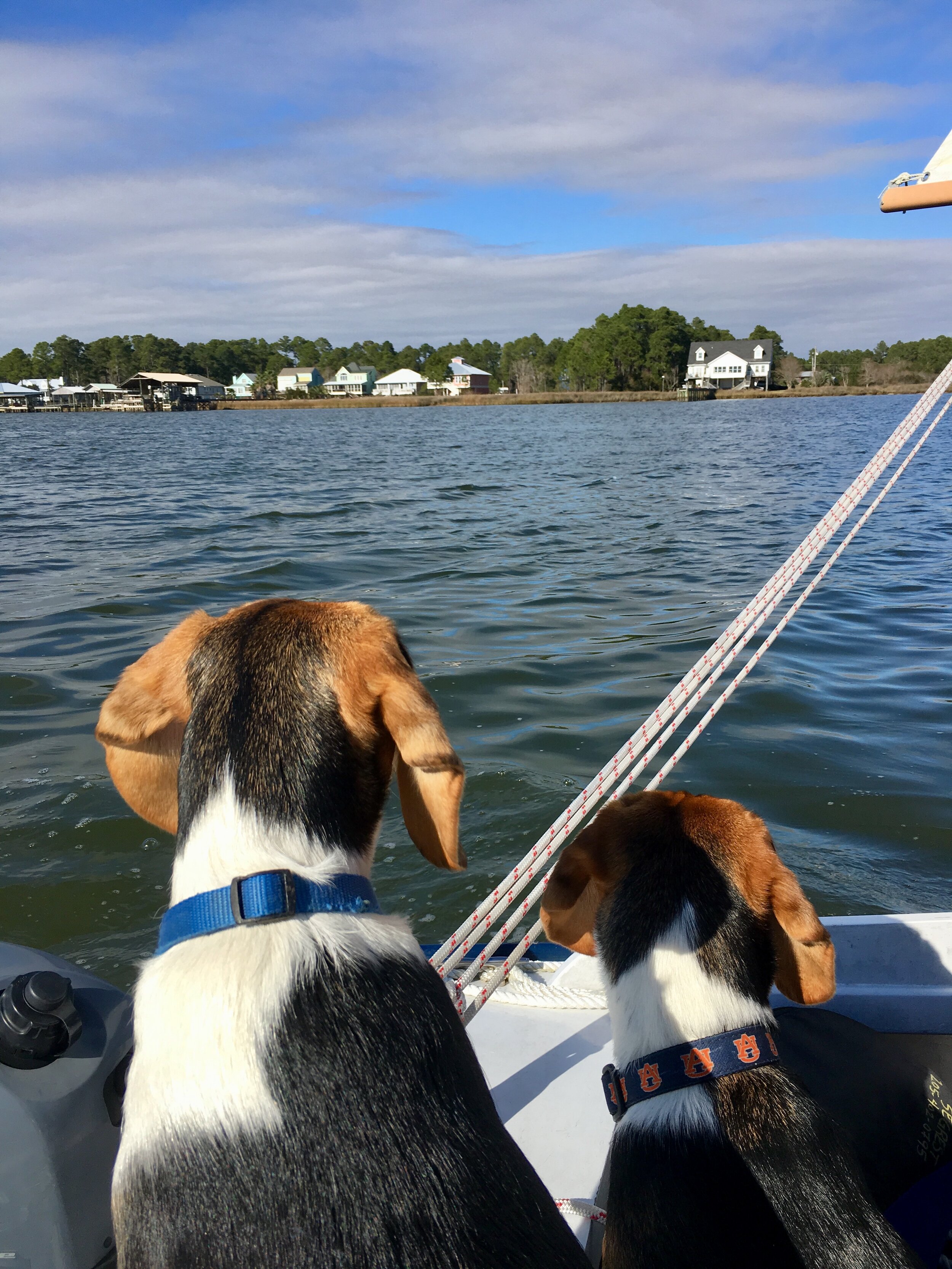
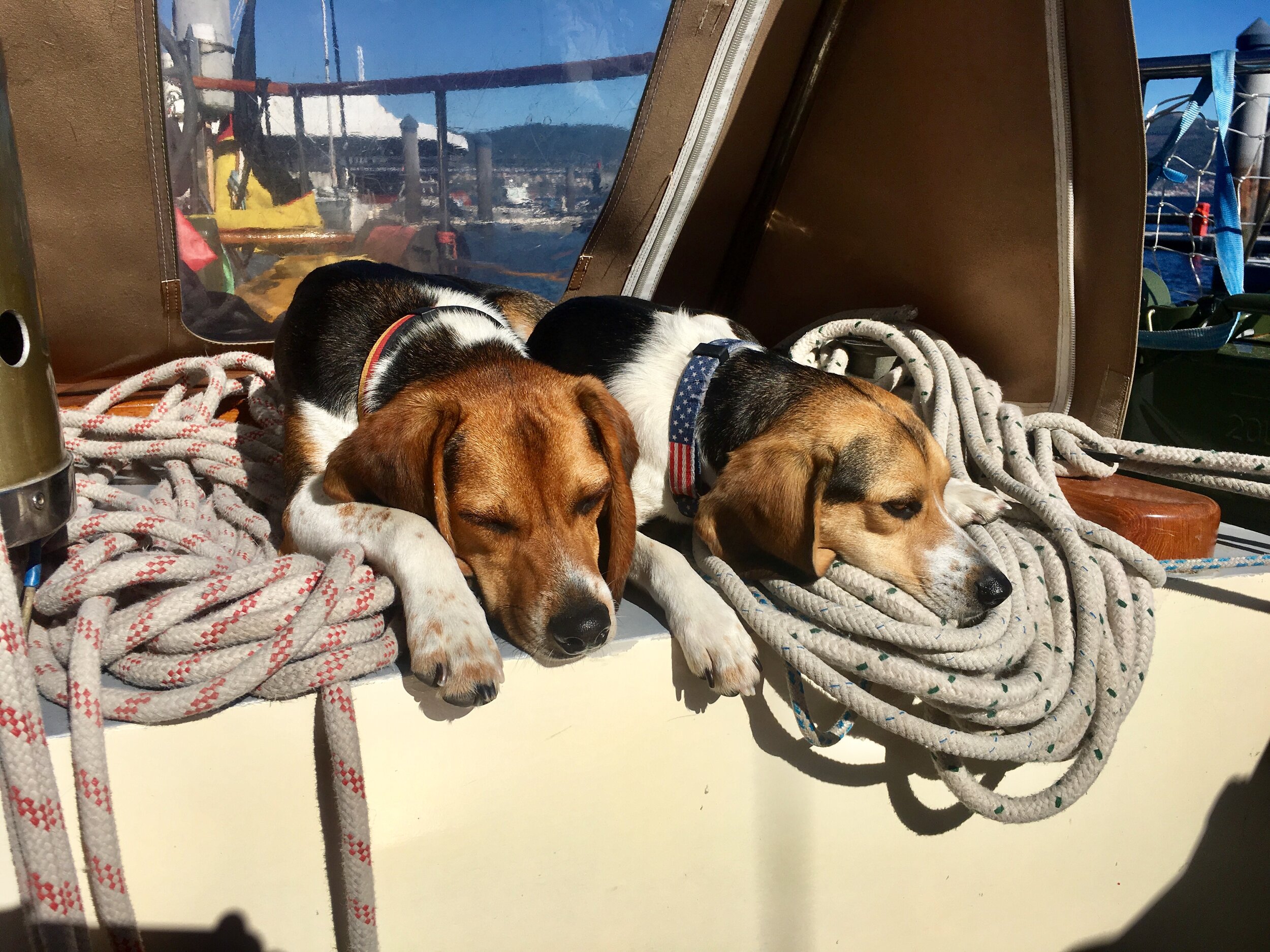
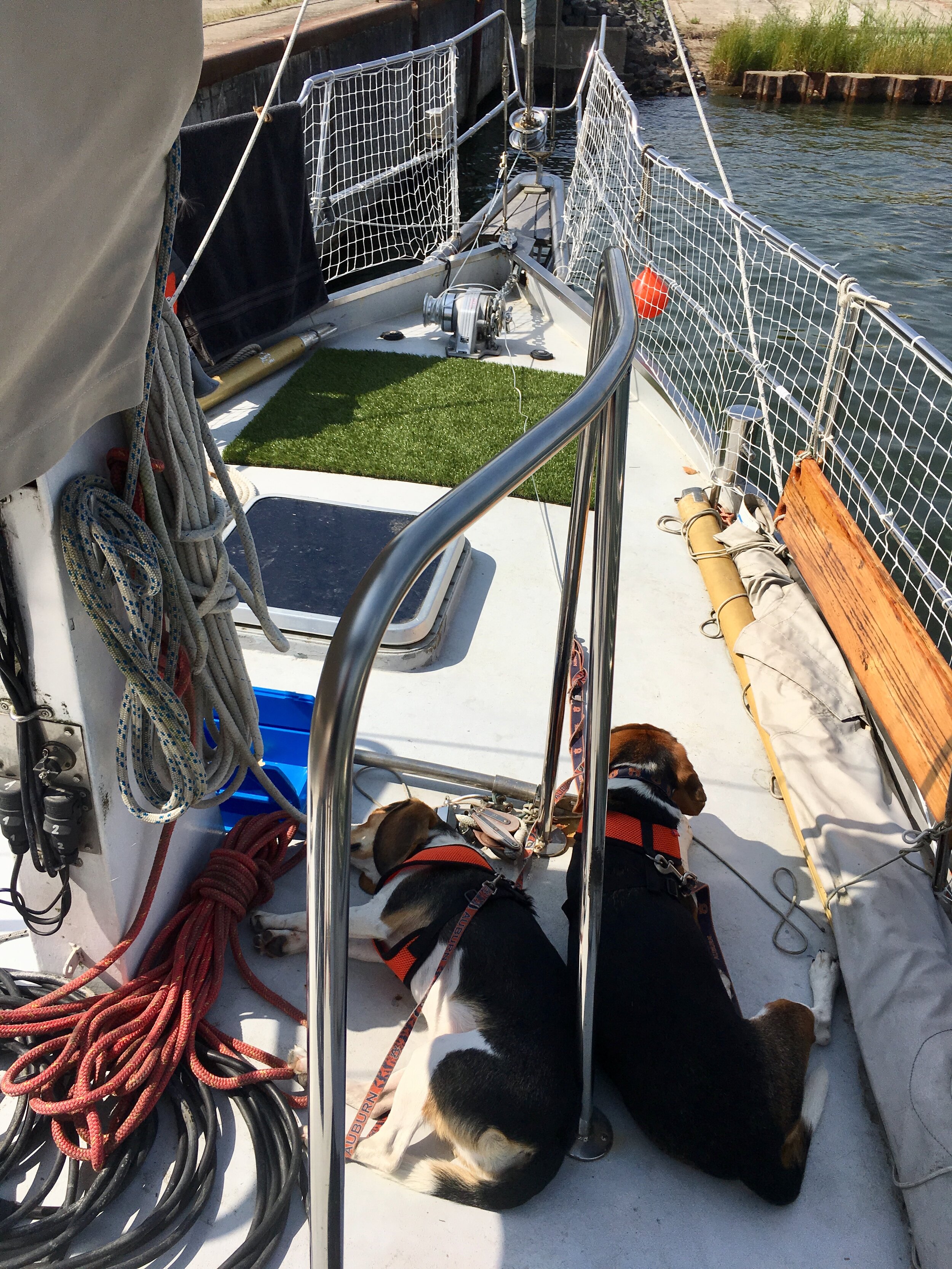
6. Keep a spare mat on board to use in a different spot when conditions are unsafe to go to the regular designated spot.
Since our “spot” was on the bow of the ship, sometimes it simply was not safe for the dogs to use it. In heavy offshore conditions, we used a spare fake grass mat in the cockpit where we had a simple draining system. A bucket of seawater would take care of the smell, and this was a much safer option in rough conditions.
7. Establish a potty routine (this may be different on land, at sea, and at anchorage).
Again, consistency is the key. While our routine was a bit different on land, at sea, and at anchorage, we did everything in our power to keep things consistent. The dogs knew that when we were at port, or at anchorage, they would most likely get many walks and opportunities to go to the potty away from the boat. They began to understand this, and we kept the routines in place. Once they were potty trained onboard, however, sometimes they were lazy and would just go on their mat, which was fine.
8. Maintain a consistent cleaning routine around the dog potty area.
No matter how hard you try, the potty area will get stinky for the humans. When it doesn’t rain for a while, clean the deck around the potty area more often. While at sea, each time the dogs would use the mat, we would dump a bucket of seawater to clean it immediately. After the scent was established on the mat, the dogs knew that was their place even when the stinkiness was washed away.
Some Obstacles to Expect When Potty Training a Boat Dog
1. Dogs may “hold it” for many days while at sea.
Our first overnight passage was stressful. Cap’n Jack and Scout refused to do their business onboard and simply “held it” for three days and two nights. We thought they might burst and feared they would actually get sick. We leashed them as often as possible and “walked” them to the mat, but they were just uneasy and unsure—most likely due to the motion of the boat and the conditions. On the third straight day at sea, Cap’n Jack couldn’t hold it anymore and used the mat. Scout had an accident in the cabin, but soon after she followed her big brother’s example and began to use the mat. While crossing the Bay of Biscay, the conditions were so rough, they held it for three days and nights and finally used the mat in the cockpit.
2. When at port, dogs may resist going on board because they know there are options.
If a dog knows a walk is in their future, they will likely hold it and wait until the walk or play time on the beach. This is ok. Just begin to think about routines at sea, at port, and at anchorage.
3. Accidents will happen.
Try not to get too mad at your dog. This is most likely a new environment for your dog, and it will take some time. Let him know that what he did was wrong, but focus more on the positive reinforcement.
Learn How to Potty Train a Boat Dog from our Mistakes and Accomplishments
Here are some excerpts from my logbook that detail some of our efforts during what I called “The Great Potty Experiment.”
August 9, 2018
Today we started The Great Potty Experiment. The time had come to begin the onboard potty training for the seadogs. We set out a mat that looks and feels like grass, but the pups were not convinced.
Granted, we made a huge mistake by laying this out on the pier and letting them nap on it for a while. A friend on Instagram suggested we place a "scent" on it–that is, a sample of their own pee or poo, so they know what to do.
So, I took the dogs for a walk and got a sample. I placed the mat on board the boat and strategically placed the sample on the mat. Cap'n Jack immediately sniffed the sample, then peed on the mat.
I thought to myself, this is going to be EASY! But, stay tuned . . .

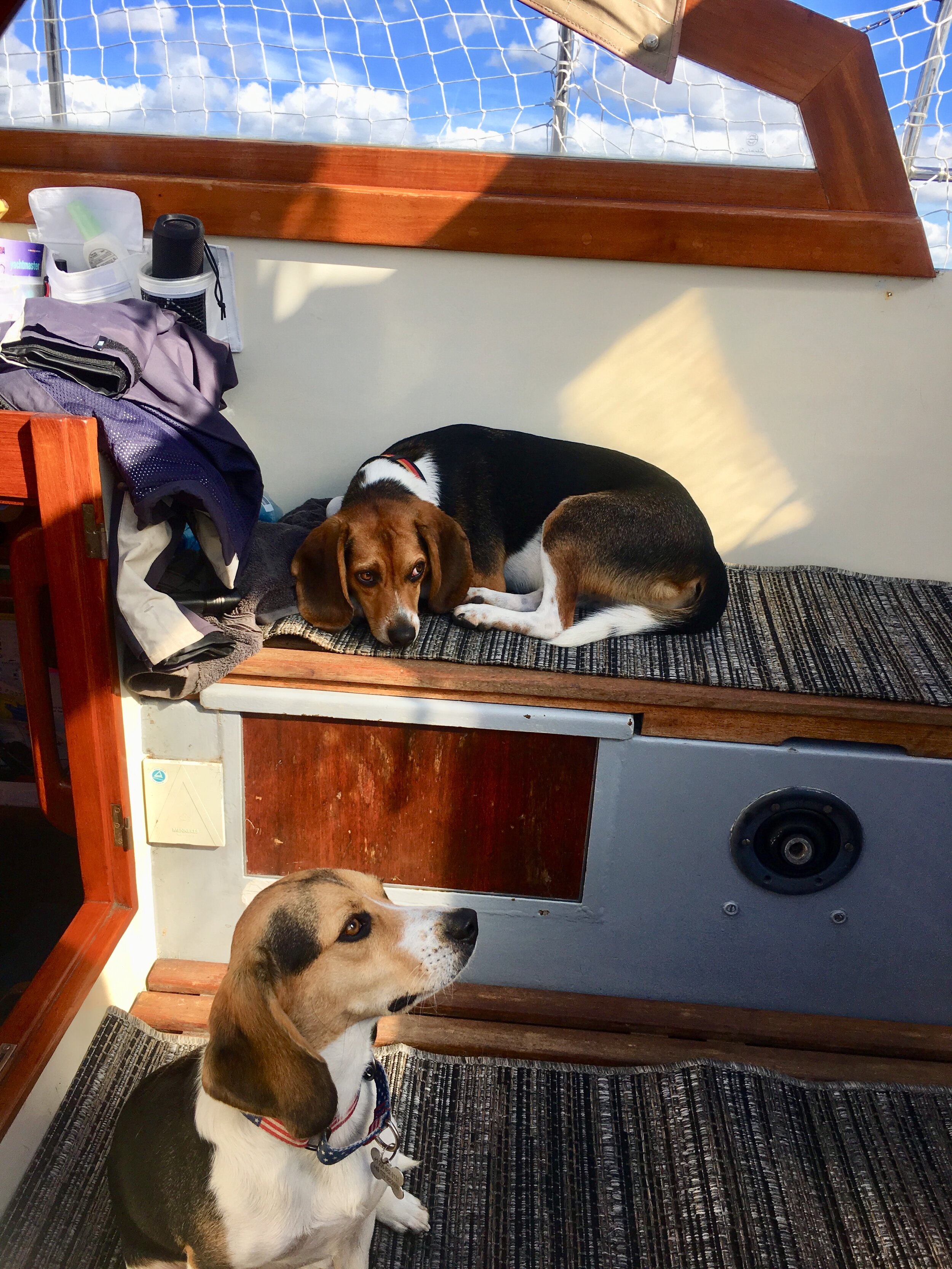
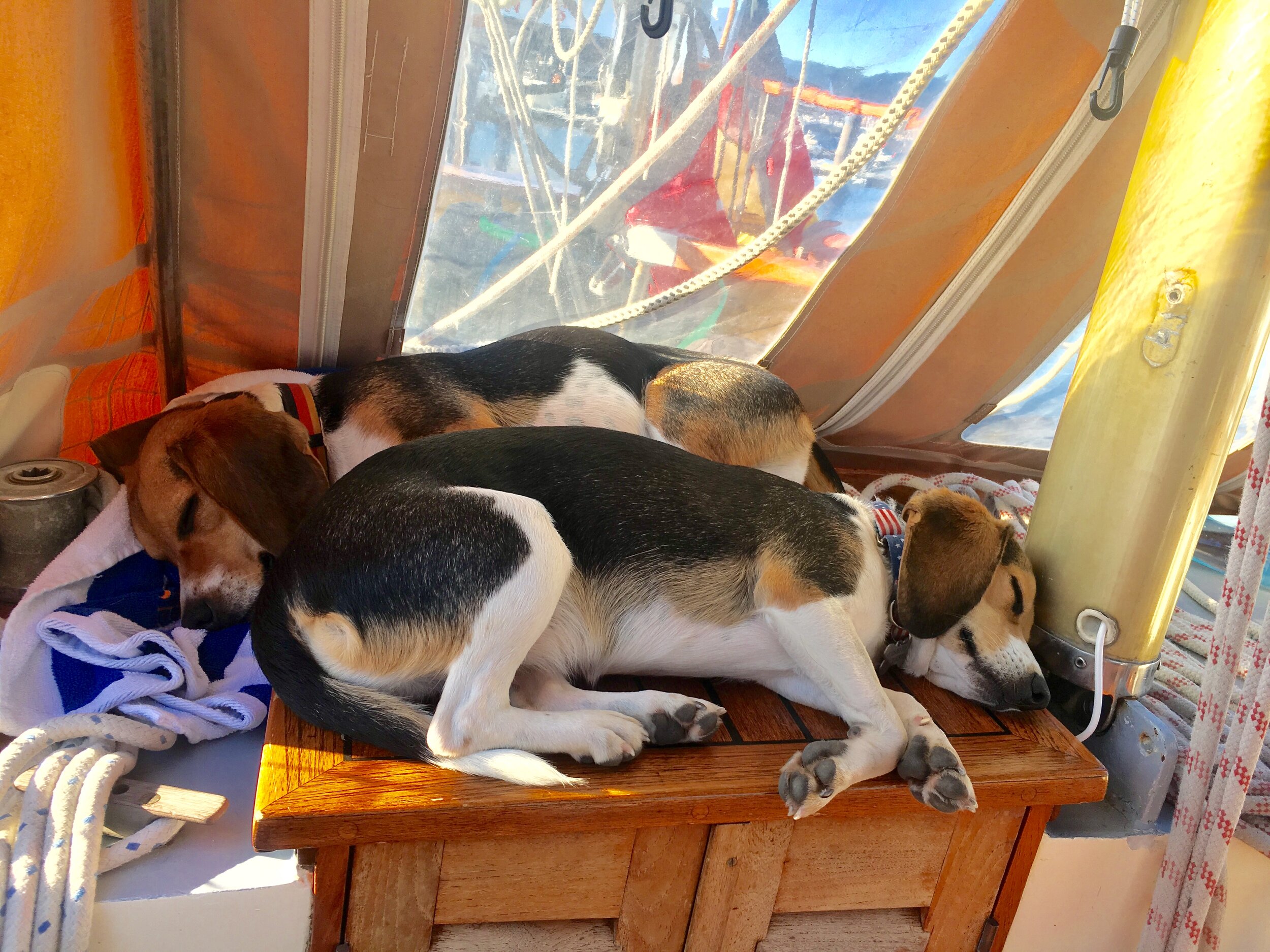
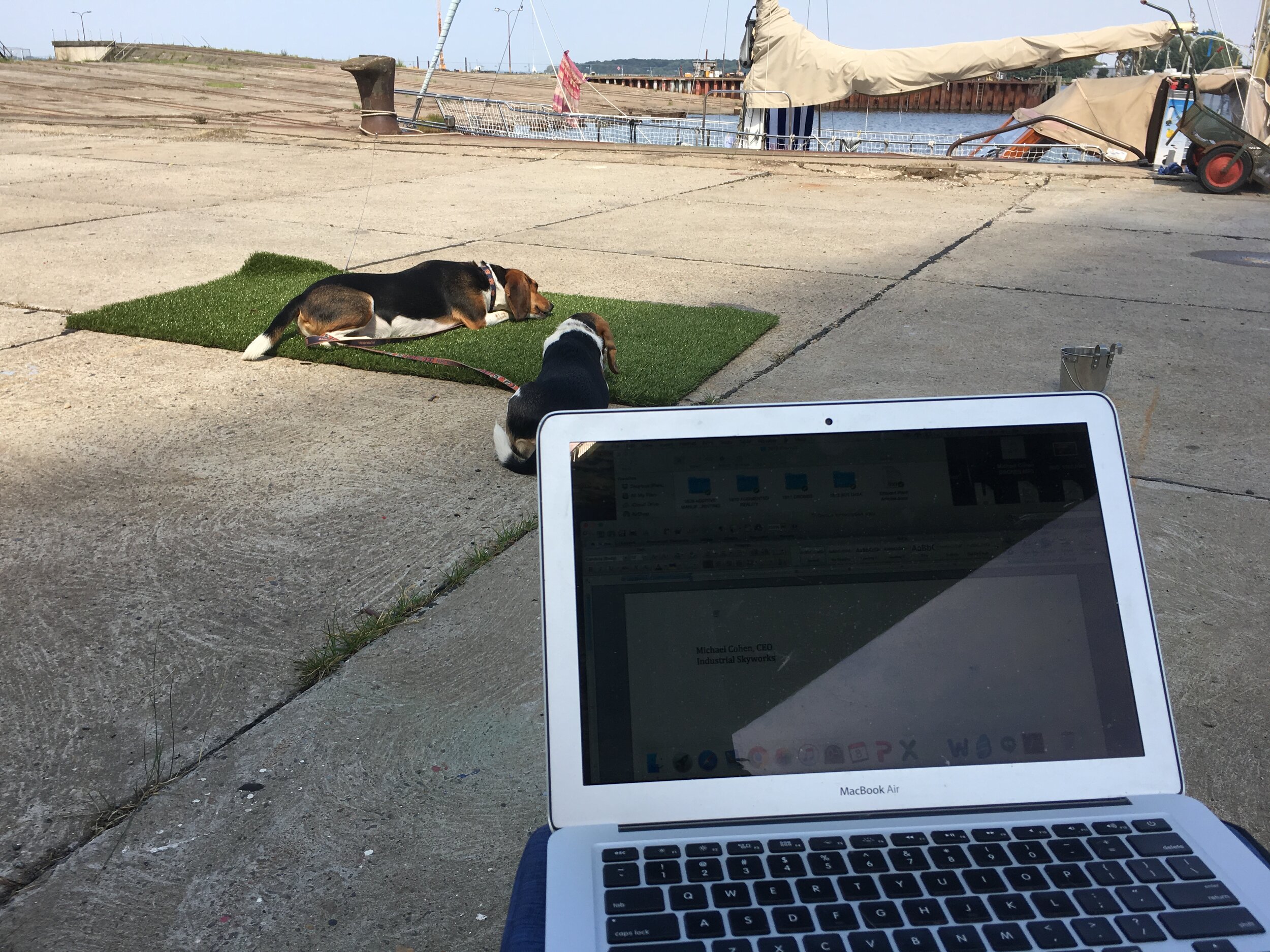
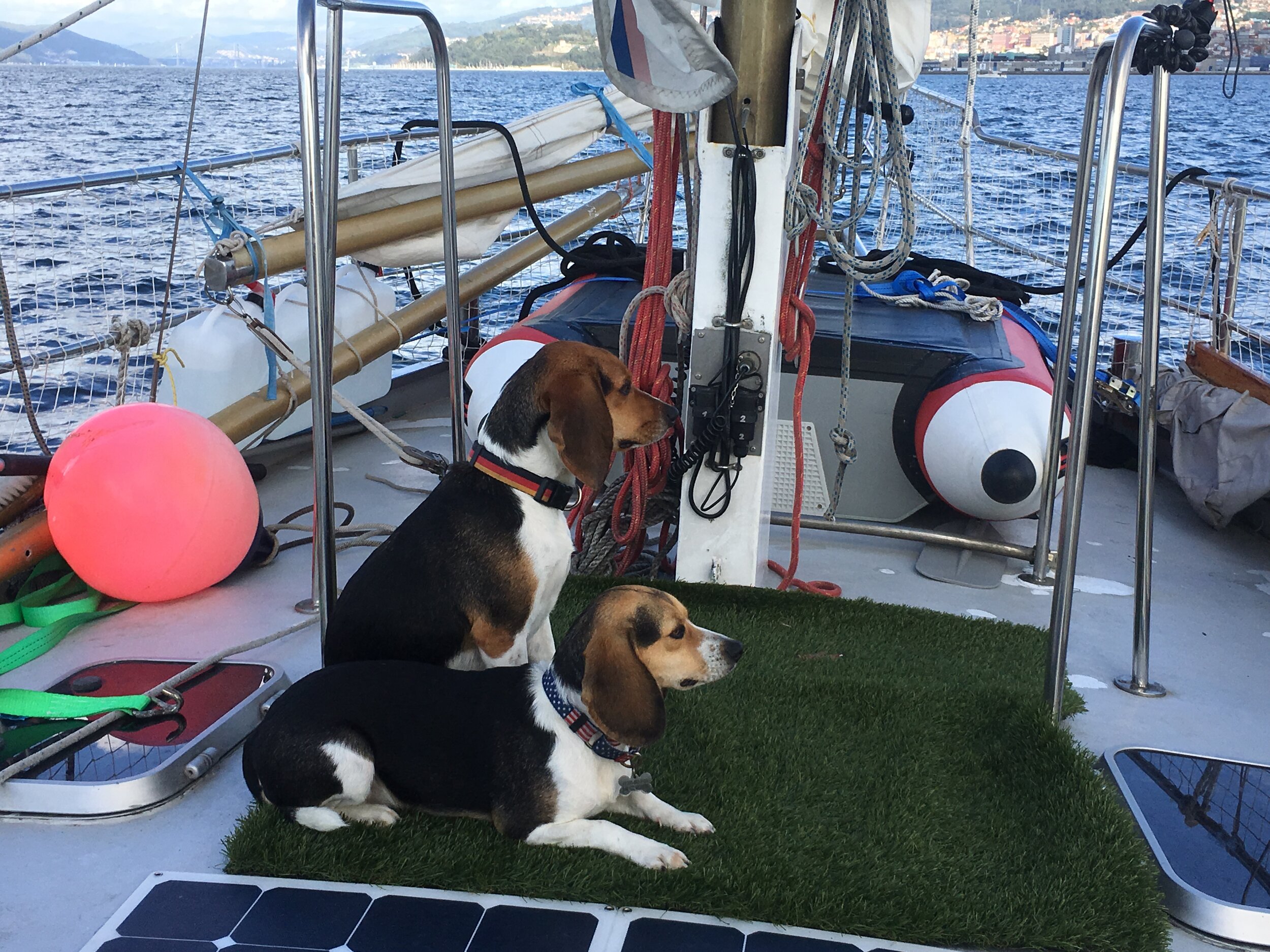
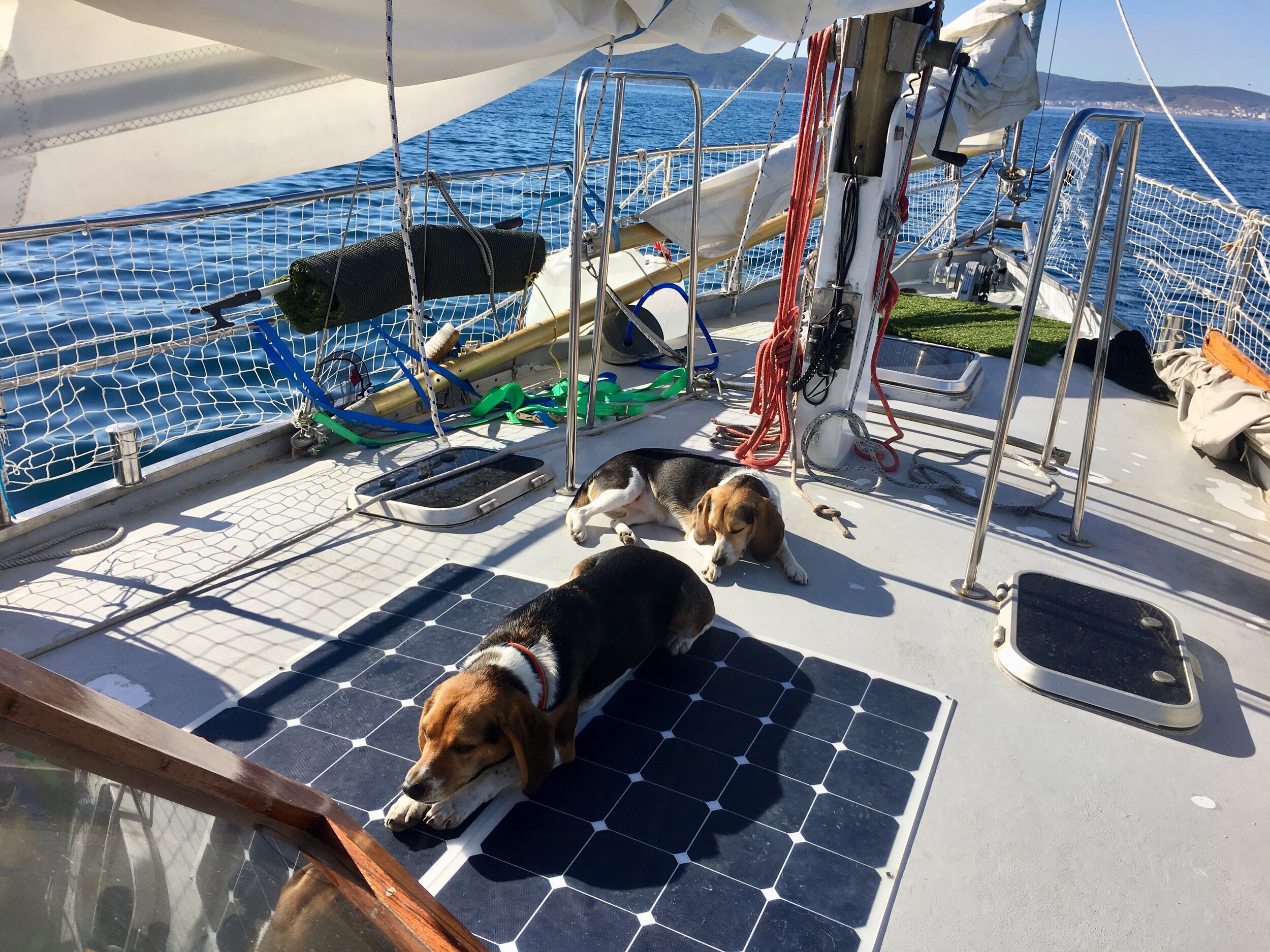
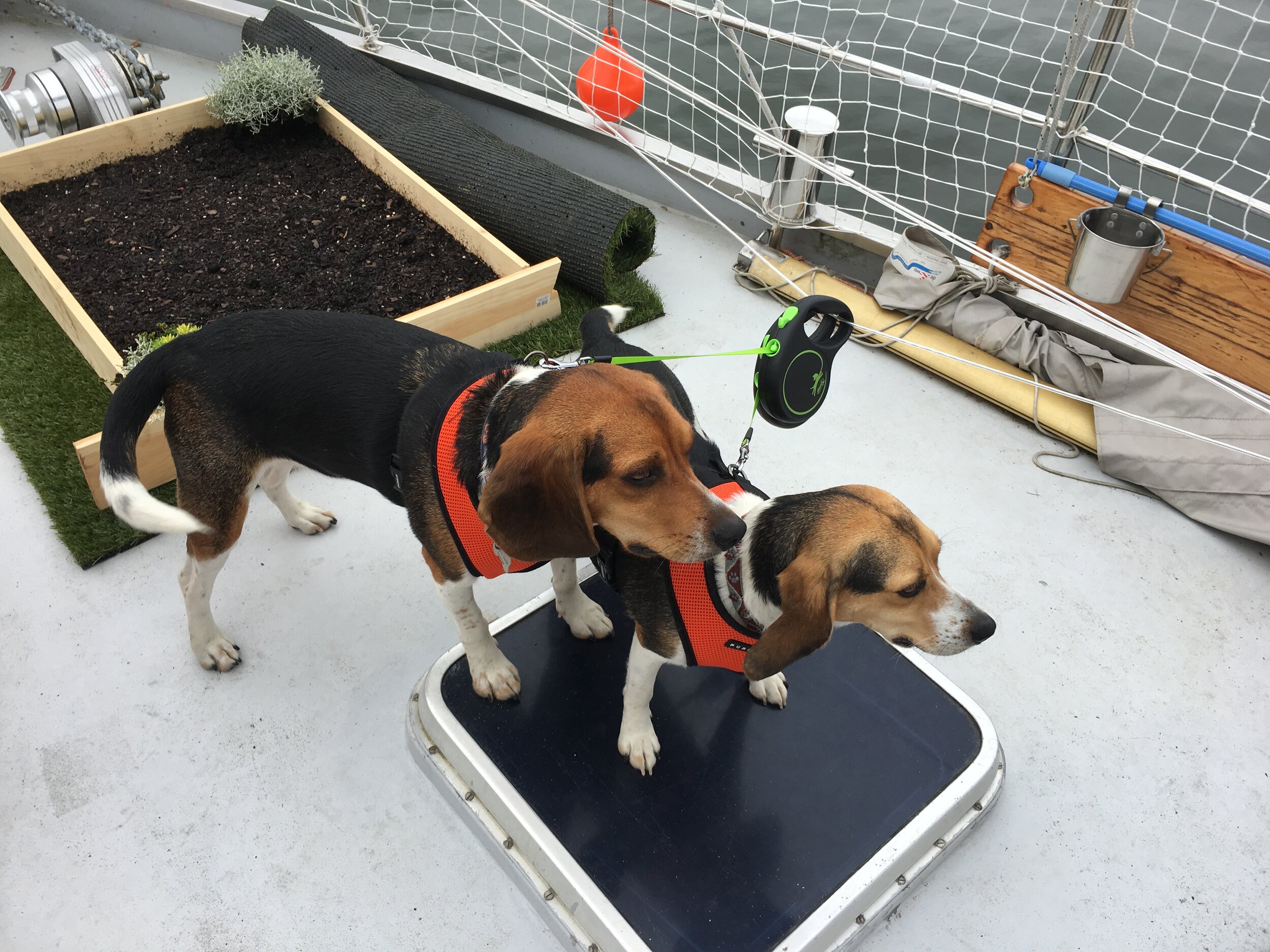
August 10, 2018
Day 2 of The Great Potty Experiment was a total bust! While the skipper was running errands to collect provisions, I worked on the potty training. I put the pups on their leashes and walked them bow to stern to bow to stern about a million times, stopping at the potty mat each time and commanding them to "potty." After 2.5 hours of this, I finally gave up and took them for a walk. They both did their business about 20 feet from the boat. The seadogs definitely won that battle!
August 11, 2018
The skipper decided to start a massive DIY project. Since the seadogs were virtually uninterested in the patch of fake grass, he went to the home improvement store and purchased some wood, dirt, grass seedlings, and fertilizer. He is convinced that the dogs need REAL GRASS on board for the potty training. He is building a little dog yard. I am skeptical, but I'm willing to try anything!
August 14, 2018
The skipper continued to work on his potty yard project. The seedlings were not growing, so we decided to “borrow” some grass and do a little transplant.
Not much progress on that end, but we are hoping this will work. The good news is the pups don't want to potty on the boat. The bad news is the pups don't want to potty on the boat.
One thing is certain: our little "garden" is getting a lot of attention in the marina. People walk by and ask us if we are growing vegetables or herbs. Then they see the dogs and immediately understand. Fingers still crossed on this one!
August 18, 2018
The dogs are still not that interested in the dog yard. They like to sit in it, but they are not yet using it as a toilet. We think that because we are still in port and they are getting regular walks, they probably know there are options. The real key will be when we get to sea and there’s nowhere else for them to “go.”
August 20, 2018
After two days at sea, the dogs are basically “holding it” when it comes to doing their business. They have been uninterested and unimpressed with the dog yard. But now the options are even more limited. While sailing through the Baltic, we faced a gale with 40+-knot winds. Unfortunately, the dog yard was destroyed and received a proper burial at sea.
More updates from The Great Potty Experiment
We switched back to the fake grass potty mat. As we traveled through The Baltic, we were making only day sails, so the pups continued to just “hold it” until we made it to port. We later talked to another sailor with a dog onboard (Molly Gillespie of Terrapin), who told us that she learned from her veterinarian that dogs won’t hold it longer than it is healthy for them to do so. Eventually, they will go—either on their designated spot or somewhere else.
Once we began making longer passages–for example, a three-day nonstop voyage across The North Sea–the pups began to realize that we were not stopping, and they had no options to go on land.
Cap’n Jack was the first to catch on and use the mat on the bow. We rewarded him with treats and lots of praise. Scout had a few accidents in the cabin before she caught on. She also wanted the treats and praise, and eventually made this connection.
We slowly began to establish an “at sea” routine and an “in port” routine.
Bottom line: we realized that when the pups know they have options, they take advantage of that. For example, if they know we are on land and can take walks, they do their business on the walks.
When they realize we are at sea and not stopping for a while, though, they use the potty mat on the bow. Dogs are territorial and will eventually establish a “place to go.”
It wasn’t easy. Developing a system, we have learned, takes a combination of effort, patience, routine, and reward.
Essential Items Every Boat Dog Needs for Potty Training
POTTY MAT
You can try to build a dog yard–but like ours, it may get damaged or destroyed in heavy sea conditions. Ours received a proper burial somewhere in The Baltic Sea. We recommend a soft fake-grass mat that has the look and feel of real grass. Get one as close to the real-grass feel as you can. But regardless of which kind of mat you use, it’s important to establish one place on board that your dog knows is his “spot.” The secret is repetition and reward! We also recommend having a backup mat, just in case conditions are rough and you need to place one in the cockpit.
DOG TREATS
Our beagles love just about anything that can be called a treat. Just be sure to have plenty on hand, especially for the long sailing journeys. If you run out, try a small cracker with a little dab of peanut butter!
POO BAGS
It’s important to clean up after your pet. This is simply the courteous thing to do, especially when you are a visitor in a new country. Keep plenty of spare bags on board, because you will need them there, too! These are also handy to have while at sea. The poo bags are not sold in every country, so be sure to keep a good supply. Throw the poo overboard, but please do not throw the plastic bags overboard.
Sometimes your dog simply won’t potty on board. Here are 9 reasons why, and some more valuable information!
You may also like these RELATED ARTICLES:
If you like this article about potty training your boat dog, please PIN IT!
This page contains affiliate links. If you click on the product links and make a purchase, it allows me to make a small commission at no extra cost to you! Thank you for your support and I hope you find value in this content!













